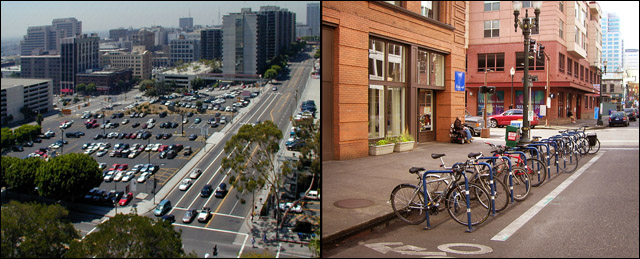Editor's note: Earlier this week, the L.A. Times published an article by usually no-nonsense columnist George Skelton, who, after being "tortured" by a road closure for a triathlon, called for California cyclists to pay a registration fee to support road infrastructure. Skelton asserted that "[cyclists] have been freeloading off motorists who pay gas taxes." Numerous analyses have shown that gas taxes fall short of paying for automotive infrastructure; car facilities, from freeways to parking, are subsidized by general purpose fees and taxes paid for by motorists and non-motorists alike. Friend of the blog Richard Risemberg submitted the following guest editorial that addresses these issues.

As anyone who travels L.A.’s streets in or on any sort of wheeled vehicle knows, our pavement is a mess. The city’s Bureau of Street Services notes that 37 percent of its 6,500 centerline miles (one mile of road regardless of the number of lanes) are grade “D” or “F.” While Los Angeles County claims a better rating for the 3,200 centerline miles under its jurisdiction, both bemoan the fact that there’s so much work to be done — and so little money to do it with. While it’s easy to blame “government inefficiency” here, the real culprit is hiding in plain sight–right there behind your windshield.
A couple of years ago, I wrote an essay called “Who Pays, Who Plays: the Gas Tax Fallacy,” which explores the cherished delusion most drivers cling to that they pay for the roads through the gas tax.
Now, this wasn’t true even in the days when eight-miles-a-gallon behemoths crowded our nation’s roads, and it’s even less so in these days of gas-sipping imports and hybrids and the occasional electric vehicle, as well as millennials’ disinterest in driving. In fact, the city of Los Angeles receives only $15 million from the California gas tax—and uses $60 million from other taxes, mostly from the general fund, to fix our streets.
There are also opportunity costs to road-building: All that broad asphalt displaces homes and businesses that would pay property, sales, and payroll taxes if they had room to establish themselves in our city.
Now the issue is surfacing in the mainstream press, especially with proposals to charge for driving by the mile, using “black box” GPS systems to monitor a vehicle’s yearly use of road space, along with suggestions that weight be a factor, too.
Of course, both right and left are terrified of being tracked by the National Security Agency, so the promise is that the boxes will track only the number of miles, not where they are incurred. (Yearly odometer readings could also work.) If driverless cars ever do become prevalent, of course, they will be utterly dependent on GPS and those pesky military satellites it uses, so the point will become moot. Private, miniature, inefficient little half-baked driverless buses will then crowd the roads, furthering our obsession with taking up too much room and pretending that the public realm is our private salon, paid for by that mysterious “someone else.”
The black box will then become normal.
But miles driven, with or without weight factored in, won’t give a full accounting of what it costs to provide asphalt wallows for road hogs.
The Portland (Ore.) Transportation Alliance recently made the comparison that it would take 9,600 bicycles to wear out a road as much as a single car, and this gives us a clue to what a true-cost accounting of road use might look like. In fact, I have been mulling this over during the years since I wrote my rant on road costs, and this is how I see it. A road vehicle’s tax should be based on all of the following factors:
• Miles driven per year.
• Weight with a standardized load.
• Footprint (large vehicles force cities to build large lanes).
• Rated engine power (more powerful vehicles tear roads up faster).
• Type of motive power (gasoline, diesel, electric, muscle).
Naturally, this should also apply to trucks, which are overused in North America, especially for long-distance transport. One of our country’s more perverted market distortions is its favoring of truck freight over railroads. Trains are four times more energy efficient than trucks, and many times more spatially efficient, using far less land per ton-mile of cargo. Railroads also build and own their rights-of-way, which they pay taxes on (along with fuel taxes)–and those taxes are then used to subsidize their inefficient competitors in trucks!
As for cyclists and pedestrians: How much should we charge walkers and pedalers for the tiny bits of infrastructure they require?
Probably nothing at all. As noted [PDF] by Todd Litman of the Victoria Transport Policy Institute in British Columbia, Canada, car-free cyclists in North America are overcharged about $250 a year to subsidize those irritable motorists who keep yelling at them to get off the road.
Time to adjust taxes so that those who insist on driving, or on driving bigger cars, pay more of their share. The program I’ve outlined above should appeal both to the left, which will appreciate its fairness, and to the right, which promotes self-sufficiency and hates subsidies.
There’s a sign I see in many shops that reads: “You broke it, you bought it.” Sounds right to me.
Richard Risemberg is a Los Angeles writer and photographer who has been covering and participating in New Urbanist, bicycling, and Complete Streets activities in Los Angeles for nearly twenty years. His recent collection of essays on urban life has just been released under the title, "Our Own Day Here."
This piece was originally published in slightly different form in the Los Angeles Business Journal.






